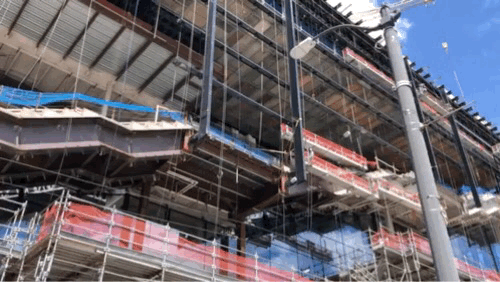Only Time Will Turn Amazon’s SLU Campus Into a Neighborhood
Greetings from sunny Seattle (it's truly sunny right now)!
I've got a list full of interesting and fun topics in urbanism, renewable energy innovations, and other climate tech-related thoughts, but it'll have to wait until we're back home.
We're on a short bi-annual trip to the Pacific Northwest, which will include stops in Bend, Portland, and Seattle before we head back to Oakland.
A massive extension to the Washington State Convention Center that I’ve watched over the last 2 years.
Right now, we're staying in Downtown Seattle and to say it's changed before our eyes is no exaggeration.
I've been visiting Seattle for a long time. In late 2012 (to early 2013) I spent almost 2 weeks out of every month in Seattle, working out of our Wallingford office next to Gas Works Park. Since that time nearly 10 years ago, I've seen different parts of Seattle transform into a tech super city, home to a growing number of billion-dollar startups and massive tech giants like Amazon.
I was fortunate to see Seattle in its early stages of growth, famously known as the headquarters of Microsoft, the Seattle metro area isn't a stranger to rapid tech-induced growth, but what I've personally witnessed in Seattle is unlike anything I've seen in San Francisco.
It's likely that these jumps in building development seem greater because I don't live in the city, but it's hard to ignore the major differences in areas such as South Lake Union, known as Amazon's urban campus, and home to more than 2 dozen corporate offices, with another dozen+ in development or planned for development.
On our short 10-minute walk from Downtown Seattle to the SLU area, as you look around you'll see the landscape change from shiny, skyscraper-sized mega buildings to mid-rise, modern buildings clad in bright facade panels or floor-to-ceiling glass windows — something you'd be familiar with coming from San Francisco or Silicon Valley.
It just feels uniform, like modern staff housing
Walking on the Covid-quiet streets at 8 am this morning, we saw at most 2-3 people walking on the sidewalks at any time. And this is normal. Yesterday at 6 pm, you'd see the same thing — quiet streets devoid of footfall, with people presumably heeding public health warnings and eating at home and ordering take out. But if you walk just 10 minutes in the other direction of Downtown into Capitol Hill, the feel is notably different — vibrant, lots of people outside (masked), with your fair share of young, old, grunge, tech worker. Capitol Hill is a vibrant, lively, community-designed neighborhood.
As I talked to Tammy about how this section of the city felt soulless, she asked me what the alternative was, but I didn't have an immediate answer.
Had Amazon not taken over the area, how much better would the SLU area be for Seattle's population? Yes, Amazon gentrified the area, drove up rent prices, pushed low-income earners out, and homogenized the architecture, but was the barren landscape of parking lots and underutilized industrial buildings any better?
It's debatable.
Everything Amazon does is deliberate, well-researched, and tactical. From the negotiated economic incentives to broad-sweeping urban planning implications (i.e. traffic, transit, homelessness), the decades-long impacts of a new campus situated in the SLU were well known long before the first project broke ground.
Understandably, long-time residents of Seattle and the SLU area have opinions — that Amazon's rapid development is devoid of character and exacerbates the housing crisis, but what alternative plan and funding source would revitalize a once lively area of the Seattle metro area in as fast a time as Amazon's? Could it be more equitable, gradual, inclusive? Consider the fact that several plans in the past were suggested and turned down by community voters, including a massive 61-acre park called Seattle Commons in 1995.
Whether Amazon is approaching this urban redevelopment project the right way or not, the conversation about rebuilding underutilized sections of a city is an important one that requires feedback from front-line citizens who have a vested interest in their neighborhoods, urban planners & policymakers who have a long term vision for the city, and developers, whose operational understanding of construction and cost make a plan a reality.
If I've learned anything from urban think tanks or urban planning experts like Gehl, it's clear that the best, most community-oriented, thriving parts of a city are the areas that have grown over time, with gradual feedback and improvement, and active listening from the top. While it's clear that Amazon's ambitious goals are leaving people out, it's also adding housing stock, and bringing opportunities to local businesses that weren't available before.
It's not a stretch to say that the area is homogenized, but even a thriving corporate area brings an opportunity to continue discourse with the mayor’s office, locals, developers, and the new residents who don't always act and think with the Amazon hive mind.
Amazon's cutting-edge mindset and city-led climate initiatives can work together to create modern, sustainable buildings designed with enhanced walkability, less reliance on centralized grid electricity, and more attention to creating a mixed living environment suitable for all walks of life.
One can only hope that other burgeoning cities on the cusp of major expansion can learn from the mistakes of creating a homogenous built environment designed for a specific type of worker citizen, and instead work towards renovating city neighborhoods with inclusive intent that shares economic prosperity while creating a built environment in the image of the people that live there. While there's a lot that Amazon doesn't know about the people and in-between spaces that make a neighborhood unique, its technology-first philosophy can create positive change when met with inclusive, people-first policy.


